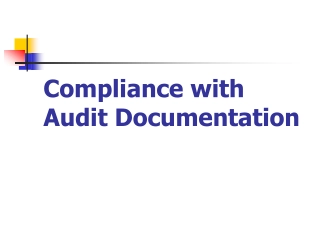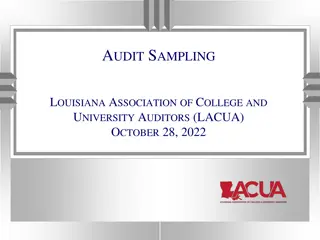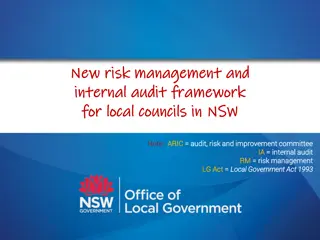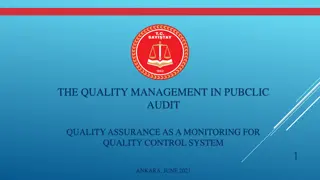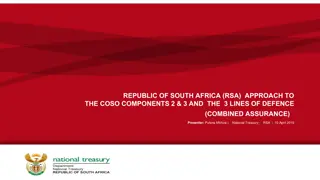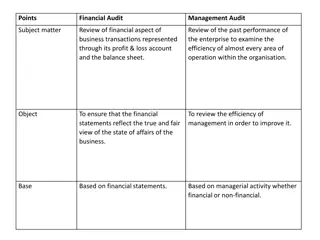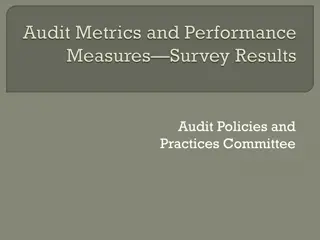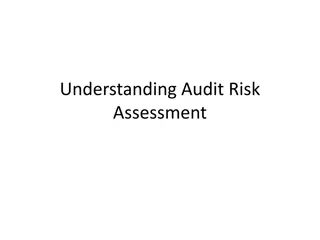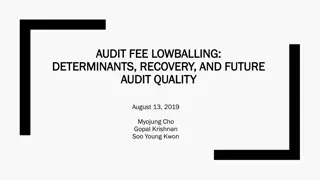
Risk-Based Internal Audit Process and Execution Overview - CA Rekha Surana
Explore the Risk-Based Internal Audit (RBIA) approach as presented by CA Rekha Surana on November 8, 2024, at the Southern India Regional Council - ICAI. Understand the evolution, benefits, and key differences between traditional internal audit and RBIA. Discover how RBIA links internal audit to an organization's risk management framework for effective risk mitigation and strategic alignment.
Download Presentation

Please find below an Image/Link to download the presentation.
The content on the website is provided AS IS for your information and personal use only. It may not be sold, licensed, or shared on other websites without obtaining consent from the author. If you encounter any issues during the download, it is possible that the publisher has removed the file from their server.
You are allowed to download the files provided on this website for personal or commercial use, subject to the condition that they are used lawfully. All files are the property of their respective owners.
The content on the website is provided AS IS for your information and personal use only. It may not be sold, licensed, or shared on other websites without obtaining consent from the author.
E N D
Presentation Transcript
+ Southern India Regional Council - ICAI Risk based approach to Internal Audit (Process and Execution) CA Rekha Surana 08-11-2024 Confidential
+ 2 2
+Agenda 3 1. Introduction to RBIA 2. Risk Management 3. Risk Families ( Risks in different industries) 4. Risk Imagination- Business Process- Case Study 5. RBIA Planning and Execution 6. Audit Report 7. Appendix- Questions Confidential
+ 4 Section 1: Introduction to Risk Based Internal Audit Confidential
+ 5 Is RBIA relevant for only large organizations on complex ERP? Confidential
+Why Risk based Internal Audit? 6 The Evolution of Internal Audit: shift from traditional, compliance-focused audits to a more dynamic, risk-based approach. Benefits of RBIA: Efficiency: Focusing resources on the areas of greatest risk. Effectiveness: Providing more valuable insights to management. Proactive Risk Management: Aiding in early identification and mitigation of potential problems. Alignment with Organizational Objectives: Ensuring that audit efforts support strategic goals. Confidential
+What is RBIA? 7 The Institute of Internal Auditors define Risk Based Internal Audit (RBIA) as a methodology that: Links Internal auditing to an organization s overall risk management framework Allows internal audit to provide assurance to the board that risk management processes are managing risk effectively in relation to the risk appetite. Confidential
+Internal Audit vs Risk-Based Internal Audit 8 Feature Internal Audit Risk-Based Internal Audit Audit plan based on the results of the business unit's risk evaluation. Risky areas are covered first and more frequently. Starts by assessing whether controls are sufficient to mitigate risks and later tests whether these controls are properly deployed. Audit plan based on the audit cycle (time duration) Focuses on compliance with P&P and the proper deployment of controls. No assessment is usually conducted on whether controls are sufficient to mitigate risks. Does not aim to assess whether there are control redundanciesFocus on risks that are not properly controlled and/or overly Scope and Focus controlled Provides assurance that important risks are being managed properly In-depth understanding of the business unit operations through risk assessment workshops and with the participation of the business unit management. More efficient use of internal audit resources by focusing on high-risk units/areas Important risks might not be covered in the audit program An understanding of business unit operations is built through a time-consuming process mapping exercise and might rely on outdated Policies and procedures Internal audit resources are spread over all business units/activities Efficiency and Cost effectiveness More objective ratings (findings are classified in accordance with pre-agreed risk importance criteria). Subjective internal audit ratings; the auditor mainly relies on his judgment on the importance of each finding. Objectivity Confidential
+ 9 Section 2: Risk Management Confidential
+What is Risk ? 10 Risk is anything that will prevent you from achieving your business objectives. A range of possible negative events that could take place in an uncertain environment. Each of these events could have a significant impact on the organization and its goals. Confidential
+What is Control ? 11 Control is broadly defined as the combination of many factors with support of people in their efforts to achieve their business objectives Confidential
+Linking Risk, Controls and Objectives 12 Risk Business Objectives Desired Result/Outcome Control Confidential
+Linking Risk, Controls and Objectives 13 Desired Result/Outcome Confidential
+Linking Risk, Controls and Objectives 14 Desired Result/Outcome Confidential
+Components of Risk 15 R I S K Accepted Adequately Controlled Insured Source: 25th The International Turkey Internal Audit Conference Confidential
+ 16 Strategic Risk What could go wrong? Industry Downturn Pricing Pressure Integration Issues Customer Retention JV or Partner Issues Market Sentiments Confidential
+ 17 Operational Risk - What could go wrong? Complacency Blind Leading Blind Dropped Batons ERP Implementation - GIGO Job Profile Vs. Org. Hierarchy Inadequate Planning. Obsolete Production Technology Non-Functional Infrastructure Confidential
+ 18 Financial Risk - What could go wrong? Volatility Market Directional Settlement Risk Geography Specific Credit Financial Risk Client Specific Asset Liquidity Liquidity Additional Financing Confidential
+ 19 Legal Risks - What could go wrong? Contractual Risk Non compliance with Terms, Technical Faults. Legislative - Non compliance with applicable laws Legal Risk Non-Contractual Risks/ Obligations - Mis-Management of IP, Social Media. Dispute Risk - Mismanagement of dispute process Confidential
+ 20 Risk Management 6. Monitoring 1. Risk Assessment 2. Risk Identification 5. Mitigation 3. Measurement 4. Prioritization Confidential
+Basic Concepts of Risk Management 21 Risk Capacity How much Risk the organization can absorb Risk Appetite How much Risk the organization is willing to accept Tolerate Cost of taking any action may be disproportionate to the potential benefit gained Transfer Insurance. Terminate Abandon the transaction Treat Continue the activity giving rise to the Risk action, but in a controlled manner. controlled manner. Tolerate Cost of taking any action may be disproportionate to the potential benefit gained Transfer Insurance. Terminate Abandon the transaction Treat Continue the activity giving rise to the Risk action, but in a Risk Response Risks cannot be completely eliminated. It can only be constrained. Risk Register A record of risks, risk assessments, mitigation and action plans prepared by the Management to support the ERM. Confidential
+Risk Mitigation 22 Risk Mitigation Techniques Tolerate Retaining Risk (Acceptance) Treat Transfer Passing on risk Terminate Avoiding Risk Reducing the impact and/or probability of risk occurrence Responsibility E.g. Insurance Activity E.g. Subcontracting Confidential
+Enterprise Risk Management 23 A process, affected by an entity s board of directors, management, and other personnel, applied in strategy setting and across the enterprise, designed to identify potential events that may affect the entity, and manage risk to be within it s risk appetite, to provide reasonable assurance regarding the achievement of objectives. Determine the Risk 1. Determine the Risk Appetite (extent of risk that the Board is willing to take to pursue the objectives) Entity Level Process Level Sub-Process Level 2. Establishing an appropriate internal environment Risk Management Policy and Framework 3. Identifying potential threats to the objectives and Risk Assessment 4. Undertaking control activities 5. Communication Information on Risks in a consistent manner 6. Central monitoring and Coordinating the Risk Management process 7. 8. Providing assurance on the effectiveness with which risks are managed. Confidential
+Risk Based Internal Audit 24 Audit is of Management of Risk and not of Risk itself. Comment whether the process laid down for Risk Assessment is adequate and has been followed Control Score is auditable Domain expertise is also essential Risk Maturity Level. Source: ICAI Guidance Note on RBIA. Confidential
+ 25 Section 3: Risk Families Confidential
+ 26 Risk Families Strategic Risk Technolo gy Risk Complian ce risk Financial Reporting risk Operatio nal Risk Risk Families Organizat ional Risk Market Risk Fraud Risk Credit Risk Third party risk Insuranc e Risk Confidential
+ 27 Illustrative risk profile in different industries Financial Services: Healthcare: Credit Risk: Loans going into default, impacting profitability. Market Risk: Losses from changes in interest rates, foreign exchange, or equity prices. Operational Risk: Fraud, errors, system failures, and cybersecurity breaches. Regulatory Risk: Non-compliance with laws like KYC (Know Your Customer), AML (Anti-Money Laundering), and data privacy regulations. Liquidity Risk: Inability to meet short-term obligations. Patient Safety: Medical errors, infections, and adverse events. Data Security and Privacy: Protecting sensitive patient information (HIPAA compliance). Regulatory Compliance: Adhering to complex and evolving healthcare regulations. Reimbursement and Billing: Denials and delays in receiving payments from insurers. Technology Risks: Failures in electronic health records (EHR) and other critical systems. Confidential
+ 28 Illustrative risk profile in different industries Technology : Manufacturing: Cybersecurity: Data breaches, ransomware attacks, and intellectual property theft. Disruptive Innovation: Being overtaken by new technologies and competitors. Talent Acquisition and Retention: Attracting and retaining skilled employees in a competitive market. Product Development: Failures and delays in bringing new products to market. Supply Chain Disruptions: Raw material shortages, transportation delays, and geopolitical instability. Quality Control: Product defects and recalls. Safety: Workplace accidents and injuries. Environmental Compliance: Adhering to environmental regulations and managing waste. Operational Efficiency: Optimizing production processes and managing costs. Regulatory and Legal: Compliance with data privacy, antitrust, and intellectual property laws. Confidential
+ 29 Illustrative risk profile in different industries Retail: Energy: Inventory Management: Overstocking, stockouts, and shrinkage. Competition: Pressure from online retailers and changing consumer preferences. Customer Experience: Providing excellent service and meeting customer expectations. Data Security: Protecting customer data and payment information. Supply Chain: Ensuring timely delivery of goods and managing supplier relationships. Price Volatility: Fluctuations in oil, gas, and electricity prices. Environmental Risks: Climate change, emissions, and spills. Safety: Accidents and injuries in hazardous work environments. Regulatory Compliance: Adhering to complex environmental and safety regulations. Geopolitical Risks: Political instability and conflicts in energy- producing regions. Confidential
+ 30 Section 4: Risk Imagination- Business Process- Case Study Confidential
+ 31 Case Study Risk Imagination Order to cash Procure to pay Governance Controls Key Business processes HR & Payroll Treasury Fixed Assets Confidential
+ 32 Risk Imagination- Order to Cash Risks: Incorrect order entry Inaccurate credit assessment Unauthorized order Unauthorized discounts Incorrect product shipments / delayed shipments Stock out situations Unauthorized refunds / returns Incorrect invoicing Pricing error Misapplied Payments Aged receivables / Bad Debts Incorrect Revenue Recognition Weak IT general controls Fraud Risks: Fictitious order Manipulating Credit checks / extending credit to unqualified customer Fictitious invoice / Ghost shipments Skimming of Cash Fictitious revenue recognition Confidential
+ 33 Risk Imagination- Procure to Pay Risks: Unauthorized Purchases Budget overruns Receiving unordered goods Shortage of goods Quality Issues Commodity Price Fluctuations Freight Channel Disruption Variance in quantity ordered vs quantity delivered Variance in agreed pricing and invoiced pricing Duplicate Payments Error in data entry Unauthorized / untimely Payments Continuous purchase from single source supplier / Absence of back up Supplier Inadequate segregation of duties Inadequate of Contract Management Lack of performance monitoring Weak IT general controls Non compliance to related laws and regulations Fraud Risks: Fictitious vendor Unauthorized purchases Selection of incompetent vendors / favoritism Collusion of vendor with employees Personal purchases Product substitution over invoicing Duplicate invoicing Ghost Shipping (ordering goods that were never delivered) Vendor Kickbacks / bribes Bid Rigging Manipulation of vendor information Transaction with Related party not in arms length Confidential
+ 34 Risk Imagination- Human Resources and Payroll Fraud Risks: Ghost Employee Buddy punching Falsified timesheet False claim of benefits Manipulation of Incentive and Bonus Computation Falsified Expenses Duplicate claim of Reimbursement Falsified referral claims Risks: Hiring Unqualified or Inappropriate Candidates Inaccurate time recording Incorrect payroll calculations leading to over payments / underpayments Non compliance to statutory requirements (Like Factories Act, Provident Fund, ESI, Gratuity, Minimum wages, etc.) Unapproved paid leave Excess claim of Benefits Inaccurate performance evaluations Unauthorized access to payroll system Weak IT general controls Data privacy breach Unapproved Loans Unapproved reimbursements Unapproved increase in Salary / Promotions Confidential
+ 35 Risk Imagination- Fixed Assets Fraud Risks: Fictitious Assets Unauthorized disposal Other Risk of Procure to Pay shall be applicable Risks: Unauthorized Purchases Inaccurate recording in books of accounts Unauthorized capitalization Incorrect depreciation calculation Inadequate impairment provision Failure to retire obsolete assets Underestimate of useful life Overstatement of asset value Duplicate Invoicing Discrepancies between physical and recorded assets Capitalization of Maintenance cost Weak IT general controls Confidential
+ 36 Risk Imagination- Treasury Risks: Inefficient cash forecasting Idle cash Unauthorized transfers Poor investment decisions Overleveraging Exposure to foreign exchange risk Poor bank relationships Inadequate hedging strategies Unauthorized intercompany loans / investments Weak IT general controls Fraud Risks: Fraudulent transaction Fictitious cash flow projections Forged Cheques Phishing Attacks Ponzi Schemes Embezzlement of cash Overstating Hedge Effectiveness Misallocation of Loan repayments Unauthorized alteration of banking credentials Confidential
+ 37 Risk Imagination- Governance Risks Risks: Ineffective board leadership Conflict of Interest Inadequate risk identification and risk assessment Noncompliance with laws and regulations Lack of segregation of duties Inadequate internal controls Inadequate data access control Unauthorized related party transaction Suppression of Whistle blower complaints Fraud Risks: Insider Trading Manipulation of Performance Metrics Concealment of Material misstatement False reporting Non arms length transaction with related party Concealment of related party relationships Confidential
+ 38 Section 5: RBIA- Planning and Execution Confidential
+Elements of RBIA 39 Planning Execution Reporting Confidential
+Developing a Risk Based Internal Audit Plan 40 Source: The IIA- Developing a Risk-based Internal Audit Plan Source: The IIA- Developing a Risk-based Internal Audit Plan Confidential
+Sources of Emerging Risks 41 Changes in management priorities, business processes, technology (IT), and operations. Ethics/whistleblower system for fraud risks. Geopolitical developments. Legal and regulatory changes. Requests from senior management and the board. New projects and change programs. Prior risk assessments from management and internal audit activity (including fraud, IT, and financial controls). Source: The IIA- Developing a Risk-based Internal Audit Plan Confidential
+Execution 42 1) Compliance Testing: These tests provide the necessary evidence to ensure that controls are properly applied (as described by management) 2) Substantive Testing: They are tests for operations, account balances, and other tests (such as analytical review) that aim to obtain evidence of the degree of completeness, existence, and the accuracy of the data in the accounting records or financial systems. They are used to examine areas where internal controls are considered weak to establish whether the risks that the controls were intended to mitigate have actually occurred. Confidential
+Internal Audit Process 43 Source: ICAI Guidance Note on RBIA. Confidential
+Risk Heat Map 44 M H H E E Catastrophic L M H H E Major L M M H H Moderate L L M M M Minor L L L L M Insignificant Almost Certain Remote Unlikely Possible Likely Low Medium High Extreme Legend Source: ICAI Guidance note on RBIA Confidential
+The Three Lines Model 45 Control Environment 1st Line : Staff are Risk Owners , they have direct responsibility for the management and control of risk. They participate in CRSA workshops and conduct self assessment tests Third Line Internal Audit Monitoring Activities Risk Assessment Second Line Risk Management and compliance 2nd Line : Risk Management monitors risks that can breach the boards appetite (tolerance level) and monitor KRIs. Compliance monitors Legal/Regulatory risks. First Line Lines of business and committees 3rd Line : Internal Audit provides independent assurance in respect of the integrity and effectiveness of the risk management framework Control Activities Information and Communication Source: Adapted from EIICA/ FERMA Guidance on the Eighth EU Company Law Directive, Article 41 Confidential
+Components of Risk - Revisited 46 R I S K Adequately Controlled Accepted Insured Working Gap Actual Gap Source: 25th The International Turkey Internal Audit Conference Confidential
+ 47 Section 6: Audit Report Confidential
+Audit Report Contents 48 Specific Location Area of Audit Observation in Brief Background of the Observation Financial Operational Compliance Impact Analysis People Technology System Design Root Cause Analysis Design Gap Absence of Control Operating Ineffectiveness Assessment Possible Solution Timeline Responsibility Conclusion Confidential
+Illustrative example of Audit Report: 49 Audit Report format Confidential
+Illustrative example of Risk and Control Library: 50 Risk and Control Library Confidential

